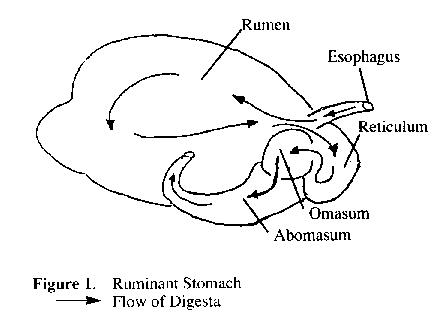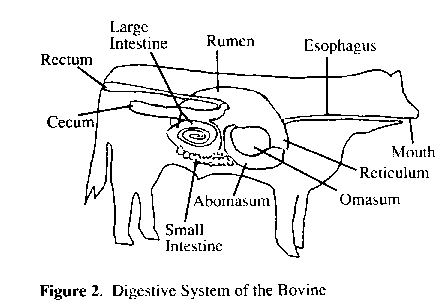Cattle belong to a class of animals called ruminants. This group includes sheep, goats and deer. Ruminants have a digestive system which allows them to utilize roughages (e.g. hay, grass) as a major source of nutrients. These animals have a large (capacity up to 50 gal.), fluid filled digestive organ at the beginning of the digestive tract called the rumen. The rumen contains a large population of microbes (bacteria and protozoa). Much of the initial digestion of feed is done by microbes in the rumen.

These microbes have the ability to break down cellulose and hemicellulose, which are main components of roughages. Rumen microbes also break down other components of the animal’s diet such as protein and starch. The reticulum is a smaller organ which acts as a holding area for feed after it passes down the esophagus. The omasum is an organ which absorbs water from the digesta (mixture of feed and fluid) before it flows into the abomasum (true stomach). The animal’s own digestive enzymes break down food in the abomasum and small intestine. Absorption of these nutrients occurs mainly through the small intestine

Monogastric (non-ruminant) animals (e.g. pigs, dogs, man) are not able to efficiently digest cellulose.
When ruminants consume forages, they take fairly large bites and swallow the material with a minimum of chewing. After eating, they stand or lie down to “chew their cud”. This involves regurgitating boluses (masses) of forage up the esophagus and into the mouth, where it is re-chewed and then swallowed. This reduces the size of the forage particles and greatly increases the surface area available for microbial digestion.
The Rumen (stomach)
The stomach of a ruminant has four chambers. The first chamber is very large and is called the rumen. The second chamber is the reticulum (honeycomb). The third is the omasum (book) and the fourth is the abomasum (the true stomach). The ruminant chews grass and swallows and it goes into the rumen. When the ruminant has finished eating, the food is brought back up and rechewed. This is called chewing the cud or rumination. If the animal stops ruminating this is a sign of ill health.
Ruminants make a lot of gas in their stomachs and belch once every minute, (unlike people they belch silently). If the belching stops the stomach swells with gas. We call this bloat or tympany (Unit 8).
Rumen movement
The rumen moves regularly and contracts about once every minute. By putting your fist on the left flank (in the hollow behind the ribs) you will be able to detect the contractions. Regular contractions are a sign of good health.


